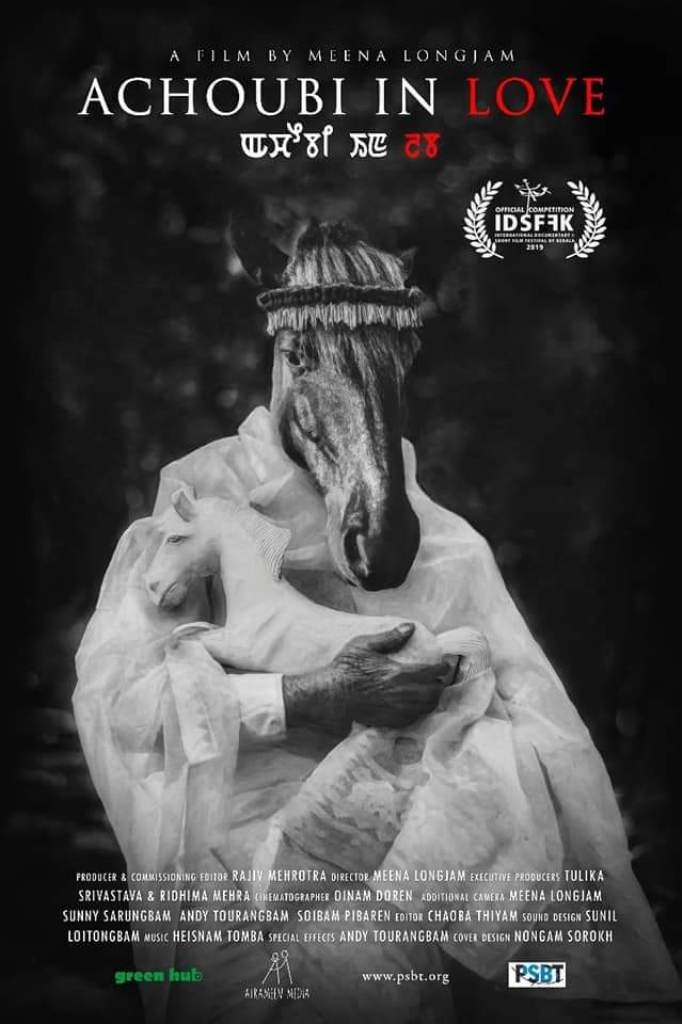
Achoubi in Love is a documentary film
by Meena Longjam on the theme of
protection of indigenous ponies, and it was screened at Mass Communication Department of Manipur University on 11th October, 2019. She conceived the idea after witnessing a dead pony on the road in a horrific condition. It broke her heart, she cried that night, even wrote a poem, and then decided to make a documentary on it to bring the attention towards the conservation of this endangered species. No doubt, the inspiration came from the right place of compassion, but, while in the process, the film seemed to have shifted its focus from the ponies to the humans. What started as a project to center the ponies in the conversation, became a glorified sympathizer for humans, pushing the ponies aside.
The only time that the film focused on the ponies was a few clips where it showed dead ponies on the road with flies on them. It was just a random shock value without any reality check or focus on how did the ponies end up there.
The film revolved around Achoubi, an old woman, who “owned” ponies because she was fascinated with and passionate about ponies and horse riding. It showed Achoubi conducting various rituals for ponies as humans do for other humans. This and other acts of humanization of nonhuman animals (here, ponies) were praised and glorified without delving deeper into its ills and wrongs. Moreover, the film also failed to highlight the selected humanization of a few ponies that only added values to human desires, be it for passion or polo. Apart from humanization, one can also see the meitei feminization of ponies in the official poster of the film where a pony was dressed as a meitei woman. Even the filmmaker said during the post-screening discussion that she was fascinated by how Achoubi “treated her ponies as humans.”
It celebrated the same old outdated idea of mirroring the dominant community for the marginalized community to be treated with respect. Moreover, the film did not show the other side of the humanization of nonhuman animals – how it harmed the ponies and the limits of humanization.
There was no mention of harms and health hazards or casualties caused to ponies because of using them in sports like polo or horse riding, carrying a whole load of a human body and continuously being ridden for hours with braces on their head. Another avenue it left unexplored was about those ponies that were not beneficial for polo or horse riding. What happened to the ponies that were considered unfit or no more fit for polo or horse riding? If the concern was protection of ponies, then why so many ponies, except for the ones used for polo or horse riding, were stranded on the road? If the love for ponies existed only because of their association with the sports or regardless of the human desires to use them? These were a few questions that the film failed to touch upon.
While there were mentions of ponies dying on the roads as a result of eating plastic and garbage, it did not explore how did these ponies end up there. The lack of sanctuaries, urbanization, and unavailability of grasses that the ponies could eat was in a few clips but it never went beyond mentions. It also did not touch upon the facts that while some ponies were humanized, the same were animalized (treated like “animals”) during horse riding or on the polo ground. The rest of the ponies not in polo or not humanized at home for various human desires, were still victims of their animal status.
On the contrary, the film laid its focus on the passion and obsession of humans on owning and riding ponies and playing polo. The toxicity of this passion and obsession on ponies was hidden under the garb of human’s love for the ponies. While the film explored the financial difficulties of Achoubi and difficulties she and other humans faced taking care of the ponies, it missed the part of how it impacted the ponies.
On top of it, the focus was extended to how polo had put Manipur on a global platform and its promotion by the government without actually addressing the harms caused to the ponies by the lack of relevant government projects and the irrelevant government (developmental) projects. In its entirety, the film made a reference of ponies yet the ponies and their issues were absent.
This was pretty evident when the post-screening discussion had an echoing celebration of Achoubi’s passion and diligence. The idea born out of care and compassion for ponies ended up in addressing the interest and struggle of humans in most of the parts. Maybe due to lack of research or maybe not. As a result, the story conceived from the right place was lost in its transition from inspiration to execution.



